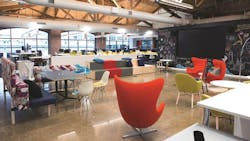Demand for Sustainable Materials Must Come from Designers
Sustainability in materials is no longer an emerging discussion; it’s part of the design industry lexicon. This, along with health and wellness, are what clients are asking for. Despite the popularity of these themes, development hasn’t kept up. That can present a challenge for you and your clients. Creating a demand and connecting with materials scientists can help them show the need and desire for such products.
“A designer can only use the materials available to them in the supply chain,” notes John Warner, president and CTO at the Warner Babcock Institute for Green Chemistry. “There’s no way that you could weld, glue, bolt or sew materials together and make them sustainable if the materials themselves aren’t sustainable.”
Peter T. Elliott, global lead for commercial buildings with the 3M Commercial Solutions Division, notes that the developments in materials science follow trends, demands and needs for commercial interior design. Beyond sustainability and wellness, he’s having conversations around enhanced experience, value engineering and design.
The challenges of these themes include developing solutions that can deliver or improve on customers’ needs of design aesthetic to create the experience they want in a functional way while meeting sustainability metrics at a desirable price point.
Warner attributes the lack of materials to the “woefully inadequate” supply side, all the way to the university level, stating that universities are slow to change. “Change doesn’t happen through academia, but through entrepreneurship and industry.”
Stephany Eaton, owner and principal of PureAlchemy Design, has seen a change, saying that education from vendors and users has become more engaging. “The challenges come when the scientific arena is tasked with finding another material to replace something that is a mainstay in the market. With those items, expectations are ingrained,” she says.
Balancing Client Needs in Materials Science
Many programs exist to evaluate the wellness and sustainability of products and buildings. They are used to measure metrics, but if things don’t change in how materials are being produced, you can only go so far, Warner states.
“The challenge facing designers right now is that no one is listening to them as much as they should be to change products, not because they don’t want to, but because they aren’t capable,” Warner says. “There’s a big difference between having the desire and having the ability to change.”
Finding the balance of what people want versus what’s possible is often what moves innovation, Elliott notes.
“For instance, you may not get the durability requirements you want from some of the biodegradable solutions. Whereas engineered solutions could be providing enhanced durability or ability to clean but without the overall sustainability aspect,” he says. “In general, it’s this balance that’s part of most new developments.”
Eaton focuses her design on sustainable human experience, and sees an increase among clients in the daily experience of employees and all environmental aspects of a space, including acoustics, visual interest, ergonomics, thermal comfort and function-friendly layout. “What we specify needs to possess not only a technical functionality, but also an aesthetic appeal,” she says.
Elliott echoes those thoughts, stating the two main purposes of surfaces in commercial design are around aesthetics and functionality.
“From the aesthetic point of view, we are continuing to see the development of man-made engineered materials that more closely mimic the look and feel of natural products. This is providing architects and designers with more options and budgetary flexibility in selecting finishes for their projects,” he says.
This gives the products the ability to include added functionality with optimization around durability, cleaning and maintenance, and repair.
“The intersection is how to do this with solutions that also provide sustainability,” Elliott says. “There’s progress here, and in some cases recycled and/or biomaterials are being utilized. There will continue to be challenges in developing chemistries and materials that can meet this balance of needs.”
Bring Together Design and Sustainability
It's getting easier to provide clients with sustainability while providing the look they want to achieve. This is important when expectations are at an all-time high, Elliott notes.
“The effects of e-commerce and online ratings/reviews are requiring these businesses to maintain and continue to update their facility to deliver an enhanced customer experience if they want to stay competitive,” he says.
To stay up to date, newer resurfacing products can provide businesses the ability to maintain or transform a space at a reasonable price point, “allowing them to continue to update the customer experience and stay on-trend with design,” Elliot says.
One of those on-trend designs that Eaton sees is color, something she’s happy to bring to projects. “That has been the most appreciated advancement over the past couple of years,” she says.
Companies want to be able to add their brand feel to a space cost-effectively, and sustainable materials available in an array of colors helps to support that goal. “A manufacturing company’s employee lounge can be colorful and full of character, and still be highly functional and durable.”
The need to evolve and bring together sustainability and design more is still present. To reach chemists and material scientists to continue development for what your client wants, Warner suggests designers make their criteria heard. That can be a Catch-22, he warns.
“If a designer says, ‘I want X,’ and no one in the supply chain gives them X, it has no meaning,” Warner says. “If they say they want X and one supplier starts to give them X, then the market’s going to change. It’s not the demand for X, it’s the ability to deliver X.”
Product Health
When looking at the safety of a chemical in a product, it’s important to remember that there’s more to a material than the presence of an ingredient. The American Chemistry Council’s Building With Chemistry looks at these risk factors:
- Hazard refers to the inherent properties of a chemical substance that make it capable of causing harm to a person or the environment.
- Exposure describes both the amount of, and the frequency with which, a chemical substance comes into contact with a person, group of people or the environment.
- Risk is the possibility of a harm arising from a particular exposure to a chemical substance, under specific conditions
The International Living Future Institute keeps a Red List of the worst materials in the building industry. These materials are:
- Polluting the environment
- Bio-accumulating up the food chain until they reach toxic concentrations
- Harming construction and factory workers
Now this:
[Sustainability] How to Give Building and Design Materials a Second Life
[Podcast] Be Original Americas 2019 Plans
About the Author

Valerie Dennis Craven
Content Strategist & Writer
Valerie Dennis Craven is an experienced writer of commercial and residential buildings and interiors, having previously served as Editorial Director for both BUILDINGS and i+s. Valerie enjoys writing about technology and how it impacts users in the built environment.
